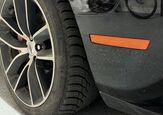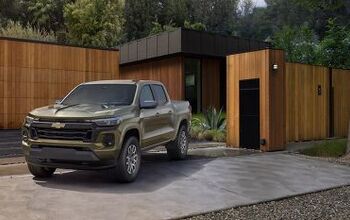Citroën CEO Claims Electrification Will Kill Boxy SUVs

Citroën CEO Vincent Cobée is under the impression that sport utility vehicles are about to become extinct. “The world of SUVs is done,” he remarked in an interview with Auto Express, claiming that the aerodynamics of electrified vehicles – designed to maximize efficiency – will probably put an end to flat-faced SUVs.
Though he also noted that the math wasn’t working in his favor at present and acknowledged that SUVs still comprised roughly half of all new car registrations in Europe.
Still, he had some evidence to support his theory. Crossover vehicles represent a meaningful portion of every market’s annual sales and they’re basically just a hybridization of traditional passenger cars and something a little more woodsy. This includes the shape, which tends to be rounded to maintain car-like performance at higher speeds and superior fuel economy.
Cobée believes that EVs will continue to evolve such vehicles into being even more streamlined.
“On a battery EV, if your aerodynamics are wrong, the penalty in terms of range is massive,” he said. “You can lose 50 kilometers between good and bad aero, and between an SUV and a sedan you’re talking 60/70/80 kilometers very easily.”
There’s also only so large you can make the battery pack before you’re doing yourself a disservice. EVs boasting enviable ranges are also some of the heaviest models in their respective segments and typically outweigh combustion-reliant counterparts of similar size by over a thousand pounds.
“People will start limiting weight and battery sizes, either through tax, through incentives, through regulation, through naming and shaming,” he said. “The A-segment has been killed by regulation, [and] the D [SUV] segment will be killed by aerodynamicism [sic] and weight,” he concluded.
Auto Express noted that France is already planning on taxing vehicles by weight in addition to Europe expanding fees based on CO2 production. Though the French company’s CEO said this would likely come in tandem with mounting social pressures.
“If you live in a big city, five years ago if you drop off your kids with a big SUV you’re a man. Now, if you do this, you’re a terrorist.”
As much as your author likes mocking executives, especially when it affords the opportunity to showcase that they’re just as dumb and reactive as the rest of us, Cobée may actually be onto something here. All of the best-looking sport utility vehicles are two-box designs with a bunch of 90-degree angles.
Don’t believe me? Start asking people about which SUVs they think are the best looking and you’ll invariably find them gushing about blunt-nosed monstrosities. Inquire about which model years yielded the best version of the Jeep Cherokee and Grand Cherokee and prepare to be shocked by learning that it typically comes down to how square the body shape happens to be. Heck, even the brand-new Wagoneer has the aerodynamics of a brick.
My supposition is that people who like SUVs also like the idea of them being rugged, multi-purpose transportation originating from military vehicles and want them to look the part. For example, the Toyota 4Runner is hugely unattractive. But we all know it’s capable and when equipped with a tasteful amount of off-roading equipment, it suddenly becomes quite handsome. Blunted faces mean shorter overhangs and flatter body panels are easier to hammer out into their original state after you’ve bashed them into a few trees.
It also has to be said that Citroën doesn’t really manufacture any SUVs – at least not in the traditional sense.
Rather than assembling purpose-built offroaders that are comfortable enough to daily on the highway, Citroën has “Aircross” variants of its family-oriented hatchbacks. While the brand calls them SUVs, they’re technically crossover vehicles – offering a more car-like experience than any of those boxy models we mentioned earlier. While none of us have ever driven the C3 or C5 Aircross (as they’re exclusive to Europe) it’s plain to see that they’d be more at home parked near a shopping center than assaulting a wooded trail.
There’s nothing wrong with this. Every automaker needs a niche in the market and Citroën’s simply hasn’t included building large, blocky SUVs. But that fact alone might explain why Cobée is so keen on their being supplanted. Because the company he represents spent a fortune pursuing EVs and barely a dime designing rock crawlers.
As with our previous post regarding BMW’s top brass griping about American politics, it’s often useful to consider executive comments in their broader context. Managers cannot predict the future. But they can often reveal a lot about a company’s biggest fears or greatest desires by attempting to convince you that they can. The best-case scenario for Citroën is for SUVs to evaporate while the entire world embraces small, electrified automobiles – because that’s what it’s selling.
“In the 1970s, a car was weighing 700kg. Today an average car is weighing 1300kg. Tomorrow an average car will weigh two tonnes,” said Cobée. “So we’re using three times more resources to deliver the same service, just to be green.”
Those vehicles are absolute featherweights compared to what would be considered normal in the United States. But things have been trending similarly, with automobiles continuing to get heavier every single year.
Citroën doesn’t see this as sustainable and has instead been moving toward concepts that utilize smaller battery packs, with relatively quick charging times. Since you’re not always going to use the entire battery the CEO suggested customers (and the environment) would be served better by smaller batteries and more charging solutions. The French automaker has been working on advanced route-planning tools and convenient charging. Citroën even has a pilot program offering short-term loans of combustion-powered vehicles for EV customers in need.
“Do you go to the office with that backpack? The answer is no,” Cobée stated. “So why would you go to the office with a car with one tonne of battery?”
With that in mind, the CEO believes the best thing Citroën could do was to stay away from large SUVs while electrification becomes more popular.
“If we stick to ‘SUV boxes’ until 2030 and discover there’s no customer, it’s going to be a hard landing … you don’t want to be the last one to leave the dancefloor.”
Of course, that assumes you’re not dancing to disco.
[Images: Domagoj Kovacic/Shutterstock; Jeep]
Become a TTAC insider. Get the latest news, features, TTAC takes, and everything else that gets to the truth about cars first by subscribing to our newsletter.

A staunch consumer advocate tracking industry trends and regulation. Before joining TTAC, Matt spent a decade working for marketing and research firms based in NYC. Clients included several of the world’s largest automakers, global tire brands, and aftermarket part suppliers. Dissatisfied with the corporate world and resentful of having to wear suits everyday, he pivoted to writing about cars. Since then, that man has become an ardent supporter of the right-to-repair movement, been interviewed on the auto industry by national radio broadcasts, driven more rental cars than anyone ever should, participated in amateur rallying events, and received the requisite minimum training as sanctioned by the SCCA. Handy with a wrench, Matt grew up surrounded by Detroit auto workers and managed to get a pizza delivery job before he was legally eligible. He later found himself driving box trucks through Manhattan, guaranteeing future sympathy for actual truckers. He continues to conduct research pertaining to the automotive sector as an independent contractor and has since moved back to his native Michigan, closer to where the cars are born. A contrarian, Matt claims to prefer understeer — stating that front and all-wheel drive vehicles cater best to his driving style.
More by Matt Posky
Latest Car Reviews
Read moreLatest Product Reviews
Read moreRecent Comments
- MaintenanceCosts Poorly packaged, oddly proportioned small CUV with an unrefined hybrid powertrain and a luxury-market price? Who wouldn't want it?
- MaintenanceCosts Who knows whether it rides or handles acceptably or whether it chews up a set of tires in 5000 miles, but we definitely know it has a "mature stance."Sounds like JUST the kind of previous owner you'd want…
- 28-Cars-Later Nissan will be very fortunate to not be in the Japanese equivalent of Chapter 11 reorganization over the next 36 months, "getting rolling" is a luxury (also, I see what you did there).
- MaintenanceCosts RAM! RAM! RAM! ...... the child in the crosswalk that you can't see over the hood of this factory-lifted beast.
- 3-On-The-Tree Yes all the Older Land Cruiser’s and samurai’s have gone up here as well. I’ve taken both vehicle ps on some pretty rough roads exploring old mine shafts etc. I bought mine right before I deployed back in 08 and got it for $4000 and also bought another that is non running for parts, got a complete engine, drive train. The mice love it unfortunately.



































Comments
Join the conversation
I don't believe he's completely wrong, tho he's probably not completely right either.
He's not wrong that barn-shaped automobiles on taller suspensions get shorter range than aerodynamic automobiles on lower suspensions using the same powerpack/motor configuration - given the same weights. Tho more aerodynamic automobiles on lower suspensions tend to weigh less too, which means they can use smaller brakes, smaller tyres, lighter suspension components, etc - to achieve the same performance, which all help to drive down weights and increase efficiency.
Manufacturers will naturally want to settle on using the same sets of powerpack/motor configurations for multiple body styles for the sake of manufacturing efficiencies and cost savings. No different from using variants of the same basic 2.0L turbo 4 + 8 speed automatic in everything from basic sedans to SUVs to performance machines.
Everything else being the same - such as interior space, performance and cost - Range-obsessed buyers will lean towards body styles which have longer range, and are therefore more aerodynamically efficient, while others who are more image-obsessed (because as we know, the vast majority of SUV's never make it farther off-road than the mall parking lot) will get the barn-shaped automobiles
Manufacturers may either add power cells to the less efficient body styles in order to make up for the aero inefficiencies - but that will come at a financial cost when it comes time to buy - or they'll let the inefficient body styles stand as they are, and buyers will have to deal with lesser range.
So while I don't see the literal end of big boxy SUVs, as one might infer from his comments - I see his comments as more of a statement that the SUV market will collapse to a fraction of what it has been, and we'll see a predominance of more efficient (and exciting) automobile designs on the road again.
Vehicles have a flat face for two basic reasons, engine placement and cooling, and front barrier and pedestrian crash protection.
Just because you can free yourself of the former, doesn’t relieve you of having to meet the latter constraints.
Aldo, unless everybody wants to be riding in high zH-point packages, there’s going to be two wheels forward if the A-pillar and a box built around that. That or there will be wheelhouse intrusion into the footwells.